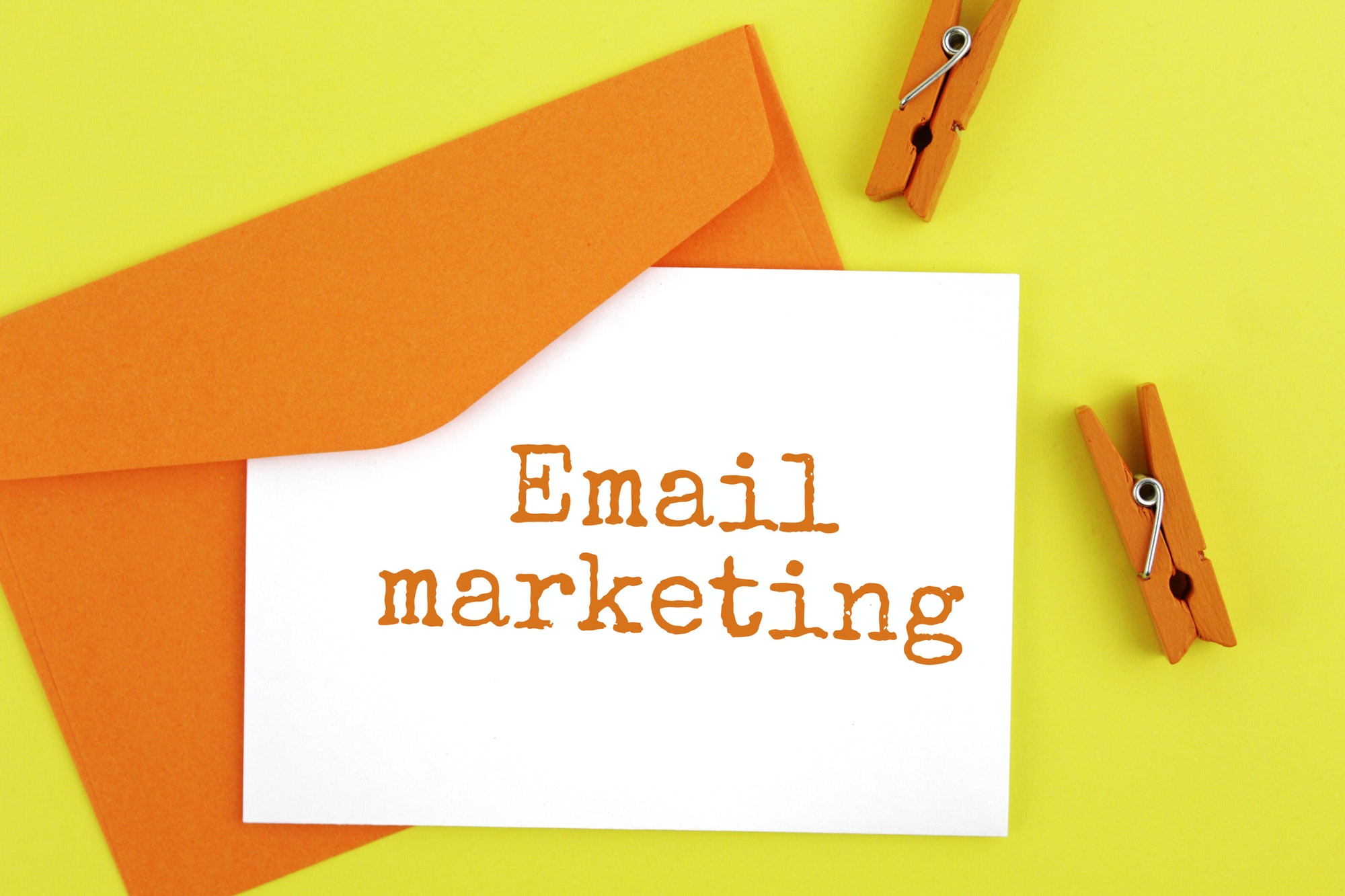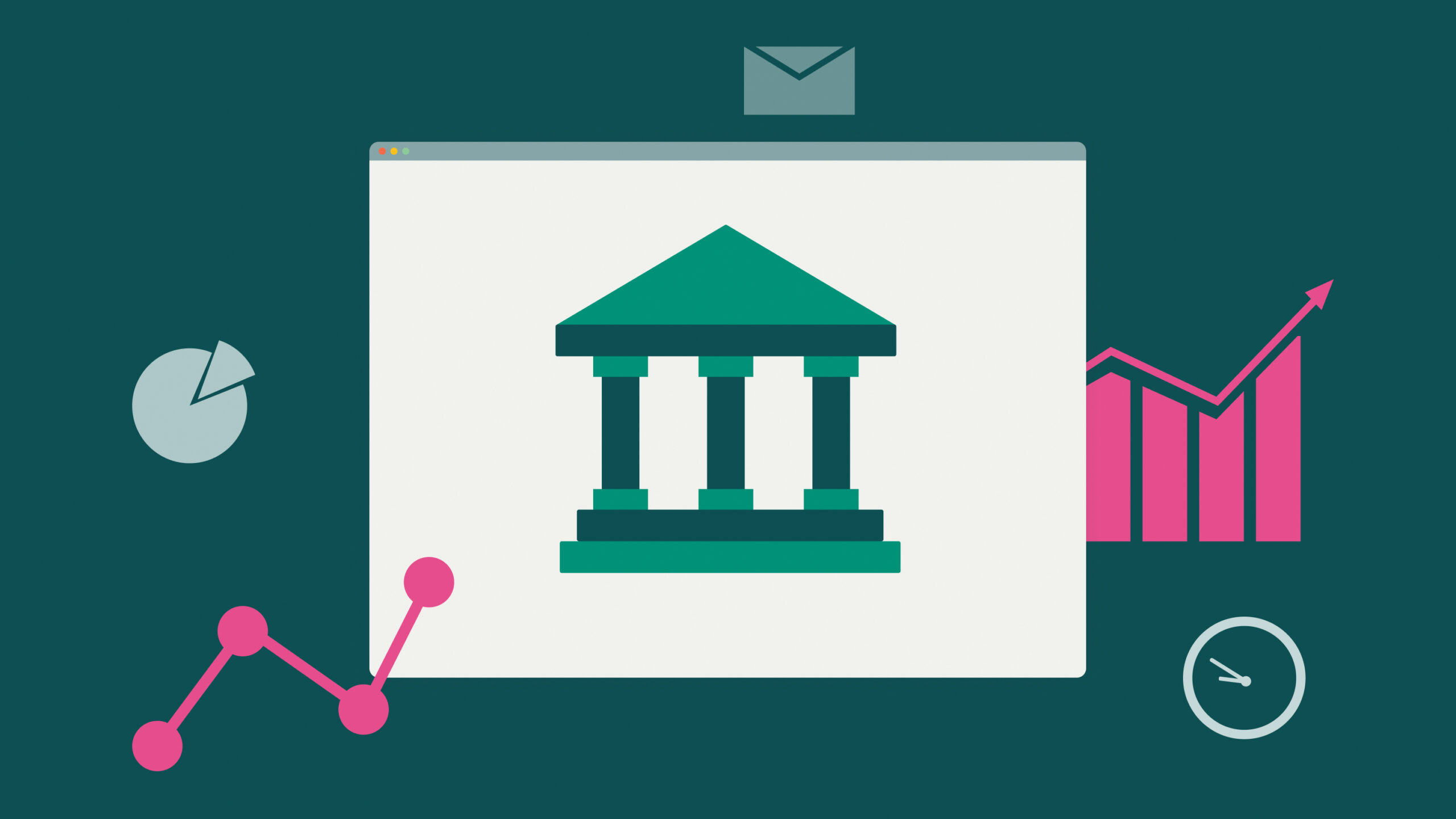Travel marketing or tourism marketing is not an easy or forgiving industry. Especially since it’s not just about marketing places and destinations, and it’s definitely not just about announcing the travel trends for each year. Travel marketing is meant to create beautiful and lucrative descriptions and make the potential traveler imagine their experience before even starting. This fact makes it one of the world’s largest and most profitable industries. This article is the travel marketer’s guide to email marketing.
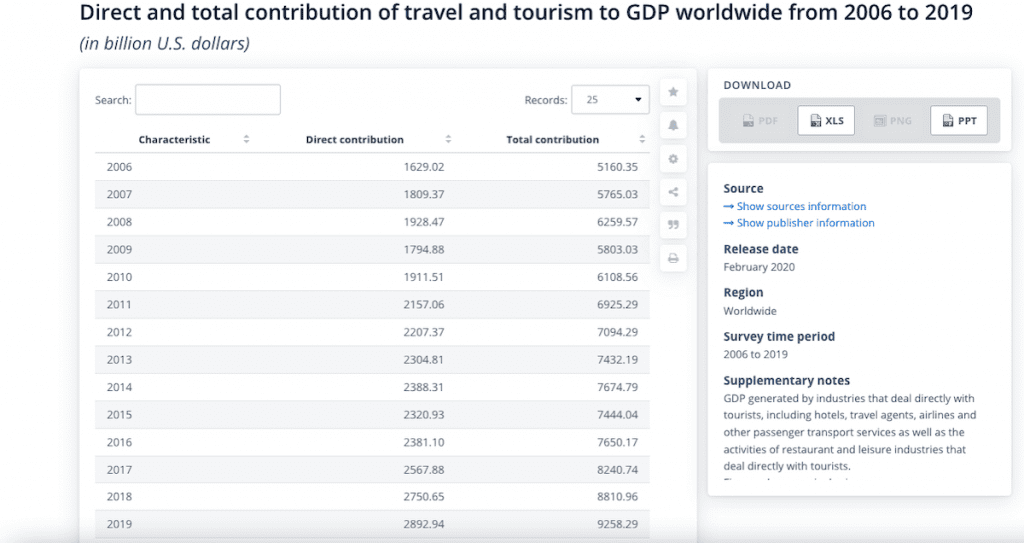
Tourism’s contribution to the GDP globally was over 9 billion USD in 2019 alone. This means that all countries can benefit from it, which, in turn, means that the competition will be fierce.
Let’s put email marketing into the equation.
Email marketing is one of the best ways to market a product, allowing you to reach new prospects and nurture existing customers with every email newsletter campaign you send. It’s also a fantastic way to build your brand, successfully promote your travel blog, and provide the prospect with somewhat of a personal experience.
But why is it needed? And how can travel marketers nail email marketing for tourism?
The Need For Email Marketing And The Perfect Software
Email marketing is not only a way to build a lasting, personal relationship with your prospects and nurture leads; they’re also an excellent tool for lead generation and a fantastic way to promote your travel services without blatantly promoting them. This leads to:
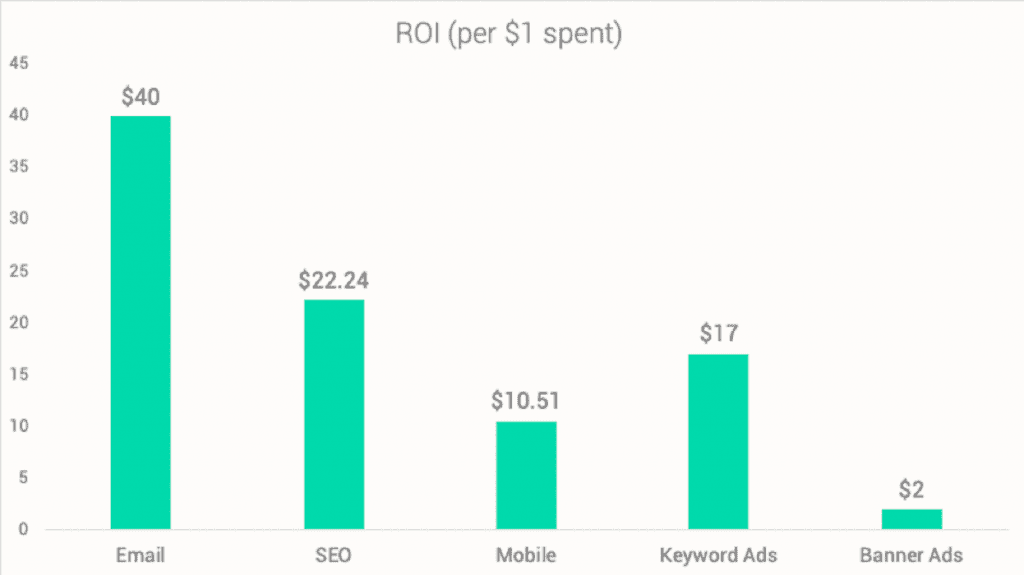
Of course, reaching that specific ROI is never easy, and there are many steps and many instances of trial and error that will take you there.
In short, you will need to apply all of the principles of email marketing’s best practices to do so, and then some. Make sure to invest in email newsletter software that can give you advanced tools: Hyper-personalization and segmentation options for your email list, subject line testers to stay ahead of the game, analytics to know exactly what works and what doesn’t, and content and suggestions that’s straight out of the user’s behavior on your travel industry’s website.
And never forget the power of fantastic copy and visuals. Your email newsletter campaign should reflect something your prospect or customer has already imagined, be it a specific experience or an abstract image. And your newsletter platform needs to have the tools that allow you to create this message.
As I said, reaching the ROI mentioned above is never easy. But it’s possible, with the right tools and the proper steps. Let’s see what those are.
Step No. 1: Creating An Email List
So, you chose your newsletter platform, you’re happy with your choice, you’ve probably created a blog to reflect your efforts as a travel marketer, and you’ve even picked out the best travel theme for it. It’s now time to start creating your email list.
First of all, create a lead magnet, like a subscription form on your website or blog. And make sure to incentivize the prospects’ efforts by giving an extra discount or an offer upon signing up.
You can also create a landing page designed to convert, attract new leads or social media followers, and turn them into subscribers. Like so:

Marriott’s landing page had a “Find Hotels” button to help those that are just looking around, and features a picture from a popular Greek destination, making great use of my location.
A landing page is a standalone page that has only one objective, and that is to convert. So, make sure to optimize your landing page by excluding any information that would not lead to that.
And never forget your repeaters or previous customers. You can send them an email asking for their referrals – perhaps encourage them to share your marketing message with their friends and family. This will get you more leads that will already be familiar with what you have to offer and turn your faithful clients into brand ambassadors. After all, you can’t build an email list without giving back to your audience – repeaters and new prospects alike.
Now, let’s assume that you’ve gathered all the emails you need. What’s your next step?
Step No. 2: Segmentation, Personalization, And Content Creation
Effectively segmenting your email list will allow you to create content that will promote your travel industry without blatantly promoting it or being bland and impersonal.
Use any parameters, from demographic data like gender and location to psychographic data, such as values and interests. This will help you create your customer personas and understand who your ideal customer is.

This, by extension, will ensure a perfect user experience that will be tailor-made and unique to each person in your audience.
Again, your newsletter platform can be a valuable tool here. Invest in one that will be able to help you using AI and machine learning. This will allow the tool to create segments so small they’ll correspond to your customers on a one-on-one basis.
After that, start personalizing. Here’s why:
Personalization is one of the most rewarding things for your travel business, as more than half of your potential customers would pay more to receive customized travel packages and suggestions. The more the offer looks like something they’d come up with themselves – in terms of the actual offer, but also in terms of visuals, with enticing photography and copy -, the more likely it is for your prospects to become customers and for customers to become repeaters.
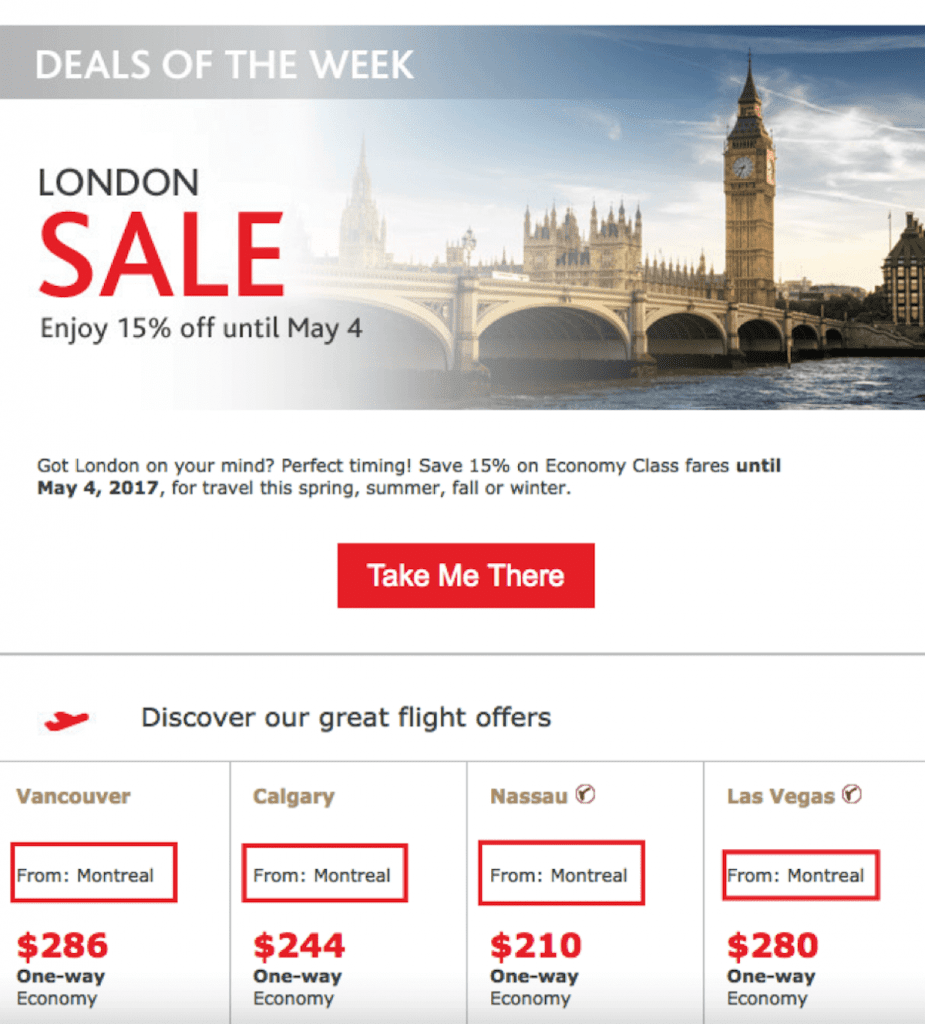
This email features information that customizes the experience for the customer. Air Canada is one of the companies that ask some extra questions upon signing up, such as the prospect’s home airport or their favorite destination. And after that, they create emails with personalized promotions, like the one above.
However, does the example above mean perfect content just because we’re talking about a personalized travel email? No, not really. You see, as a travel marketer, you’ll need to send travel email marketing campaigns that will help you hit your conversion marketing goals and boost your ROI, and personalized offers can only do so much.
Make sure to create a wide variety of content types. For example, how would you feel about a personalized destination guide or travel tips on the destination the visitors of your website have just shown an interest in? Tapping into your data will give you all of the information needed to create email newsletters that will gently nudge prospects further down the funnel.
Other content types you could try could be:
- Video content of testimonials from travelers who loved a destination similar to – or the same as – your user’s favorite destination.
- Quizzes and interactive content will help the travel email’s recipient pick out their next destination.
- Information on the yearly activities and festivals of a specific destination, as well as little-known secrets about the culture.
- Content featured on your social media or your blog. This will create a unanimous brand and increase interactivity, followers, and blog traffic organically.
- Use their location and create content based on that. You can create weather-based emails, suggest an offer that includes the closest airport or the nearest destination for a long weekend getaway – or both.
Pro Tip: Content is nothing without proper timing and, of course, A/B testing. Sending too many emails with boring content can make users unsubscribe at best or mark your travel email campaigns as spam at worst. Both will harm your deliverability rates and, by extension, your travel brand’s reputation.
Step No. 3: The Travel Email Campaigns a Travel Marketer Needs
Now, let’s talk about the types of campaigns a travel marketer needs to utilize to make sure their travel marketing message will be heard and welcomed by prospects.
The Welcome Email Campaign
An automated welcome email is always a good idea. In general, prospects expect to receive a welcome email and are sure to open it, which means that it’s perfect for content that greets, welcomes, and offers a discount.
Just set up an automation trigger for the customer segments that have just signed up for your content and send them an email that encourages them to get to know your amenities and your destination.
The #travelinspo Email Campaign
You will have to try a little harder for that campaign, as some people love roaming off the beaten path, and some others are looking for the most popular destinations.
As a travel marketer, you need to remember that you’re also a content creator who needs to create marketing magic by segmenting and personalizing an offer that resonates with your prospects and inspires them. You will need different visuals for those who looked into less popular places, even if they’re around the same location as more popular ones.
For example, you can use pictures of the beautiful reefs of the Raja Ampat Islands in Indonesia to entice the adventurers and visuals of Bali’s beautiful white sandy beaches for the more “touristy” ones.
The Classic Travel Email Newsletter
A travel email newsletter can include anything from news to special offers and customer testimonials, so it can be a fantastic opportunity to gently promote any offer you’ve got at that moment.
Include a testimonial video or a review if you’re running a promotion on a specific destination. Travelers – as well as all types of customers – love reviews. By helping them make their decision, you’re proving that you’re transparent. This will earn the prospects’ trust and give you more points, authority-wise.
The Traveler’s Birthday Email
Birthday emails are no longer a thing of eCommerce alone. When users sign up to receive your travel email marketing campaigns, you can ask for their date of birth. If not, you will surely need their date of birth upon reservation.
Now, you can do either of two things – or both: Prepare a special surprise for those that have made a booking – if their birthday is around the time they get to your resort or facility, of course – or send a birthday email every year with a special deal. This is a lovely way to create content for the prospect’s special day and offer them something nice, something that could be an impulse buy even. It won’t be a huge commitment on their part, and it won’t break your budget either.
A great way to figure out what your audience deems an irresistible offer would be to create a quiz or send out a survey asking what they’d find more valuable. That way, you’re gathering valuable data, and your audience interacts with a brand that cares enough for their audience to need their opinion and put their words into action.
You get extra points if you add buttons for online payments to be done through your email. That way, your recipient will never leave their inbox, and you’ll take full advantage of the impulsive nature of purchasing.
The Thank You And Please Refer A Friend Email
Let’s assume that your prospects have traveled. You’ve sent your booking confirmation, they’ve loved their time at your resort or your facilities… Now what?
You still need to keep your customers engaged and coming back for more. This is the perfect time to send a post-departure thank you email campaign.
A thank you email campaign is a great way to ask for feedback in all industries – and the travel industry is no exception. So, send this thank you email campaign asking for feedback and – if they loved and would promote your services – asking for referrals as well.
Don’t forget to incentivize their effort with a voucher or a special discount for every new lead, and you’ll create a referral program in no time.
The Takeaway
Email marketing for the travel industry is not that complicated, and, with the right tools and efforts, it can be a valuable arrow in a travel marketer’s quiver. We hope the travel marketer’s guide to email marketing helps in your endeavors.
Just don’t forget to pick the right ESP; always A/B test your content, keep track of your data to make informed decisions, and, most importantly, make sure you create travel email campaigns that will be mobile responsive and look good on any device.
Author Bio:
Téa Liarokapi is a Senior Content Writer for Moosend, an email marketing and marketing automation platform, and an obsessive writer in general. In her free time, she tries to find new ways to stuff more books in her bookcase and content ideas – and cats – to play with.
